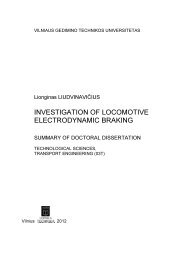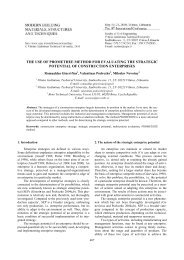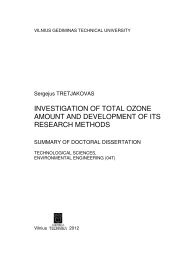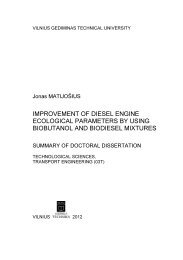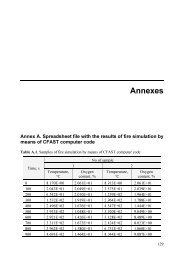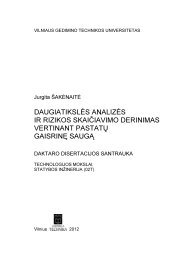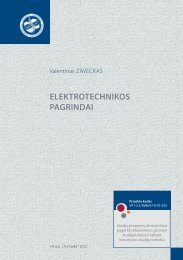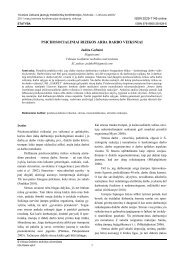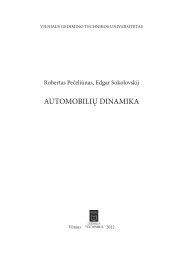ðÑÂрþôøýðüøúð òþ÷ôухþþчøÑÂтýых уÑÂтрþùÑÂтò Ѡ÷õрýøÑÂтыü ÑÂûþõü
ðÑÂрþôøýðüøúð òþ÷ôухþþчøÑÂтýых уÑÂтрþùÑÂтò Ѡ÷õрýøÑÂтыü ÑÂûþõü
ðÑÂрþôøýðüøúð òþ÷ôухþþчøÑÂтýых уÑÂтрþùÑÂтò Ѡ÷õрýøÑÂтыü ÑÂûþõü
You also want an ePaper? Increase the reach of your titles
YUMPU automatically turns print PDFs into web optimized ePapers that Google loves.
314 Summary<br />
The basic advantage of these catalysts is low aerodynamic resistance, resistance to<br />
erosion and the possibility of cleaning gas polluted with suspended particles. As<br />
practice shows, granulated catalysts can be employed for gas treatment when the<br />
concentration of suspended particles inside does not exceed 2 mg/m 3 (Darlington<br />
et al. 2001; Gelhomenie et al. 2001, 2002; Deshusses, Cox 1999; Deshusses, Johnson<br />
1999, 2000; Devinny et al. 1999; Dhamwichukorn et al. 2001; Elmrini et al.<br />
2004; Engesser, Plaggemeier 2000; Estimated ... 2006).<br />
The main function of charging a bio-filter is to create a large surface for pollutant<br />
adsorption. Charging is also used as a source of nutrients for microorganism<br />
population. In some charges, the required nutrients are not enough, and therefore,<br />
in order to ensure high activity of microorganisms, they need to be watered with<br />
water-saturated biogenic elements (mineral salts). Peat, soil, compost and mixtures<br />
thereof are for the most part used to biologically clean the air from organic and<br />
inorganic chemical pollutants. Wood sawdust, bark and various types of crushed<br />
waste have also received wide application globally. Moreover, the charges of the<br />
artificial origin such as polyvinyl chloride balls, star-shaped polymers, polypropylene<br />
cylinders, balls filled with carbon or ceramics, granulated glass, ceramic cubes<br />
are used to reduce the aerodynamic resistance of bio-filters. An inorganic charge of<br />
natural origin and natural zeolite can also be applied for biological air treatment.<br />
The advantage of zeolites is their regular structure, a large internal specific surface<br />
(around 600–800 m 2 /g), pores of the same size and good thermal stability. One of<br />
the major factors determining the selection of charging is its aerodynamic resistance<br />
which is directly related to the porosity and humidity of charging. A higher<br />
aerodynamic resistance of charging is obtained upon increasing charge humidity and<br />
reducing fraction. It can be stated, therefore, that the major factors having an influence<br />
of filter treatment efficiency and the amount of used energy are the selection<br />
of filter charge and its humidification. For a standard bio-filter, pressure losses may<br />
reach from 1 to 10 hPa. This chapter analyses the structural peculiarities of air treatment<br />
bio-filters and presents related proposals aimed at reducing the aerodynamic<br />
resistance of these devices (Reza et al. 2005; Ruokojarvi et al. 2001; Schwarz et al.<br />
2001; Sercu et al. 2005 et al.).<br />
Chapter 3 The Structure of a Granulated Charge Layer overviews literature on<br />
the properties of this type of charging and describes methods for determining the<br />
porosity of a granulated charge layer. Recently, methods for research on the granulated<br />
charge structure have been developed and improved which can be applied<br />
for investigating prospective high-temperature nuclear reactors with gas cooling<br />
(Morales et al. 1951; Schuter, Vortmeyer 1981; Аэров 1951; Аэров, Тодес 1968;<br />
Аэров и др. 1979; Lyczkowski 1982; Бесков, Абаев 1980). This chapter presents<br />
the dependences of the porosity of charging on its form which shows a lesser porosity<br />
of a layer of cylinder-shaped granules than that of a layer of granules having<br />
a round form. It also discusses the results of research carried out by Zavelev, Robl



